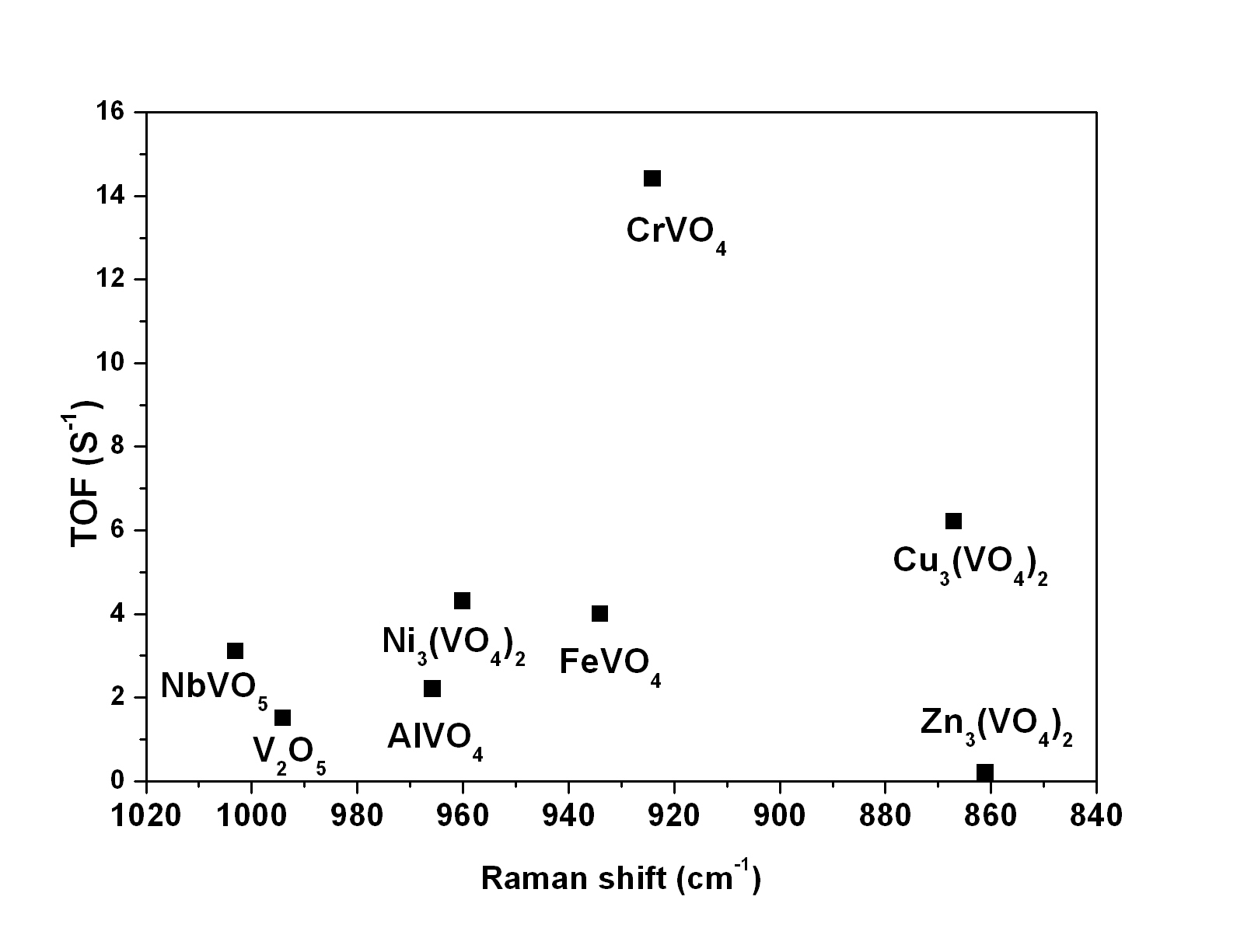192b Surface Science and Catalysis of Mixed Metal Oxides
Introduction
Bulk and supported vanadium oxide catalysts find wide application as oxidation catalysts, but many fundamental questions are still unresolved about these important catalyst systems. To better understand the similarities and differences between bulk and supported vanadium oxide catalysts, their surface catalytic active sites were chemically probed with methanol oxidation.
Experimental
The supported vanadium oxide catalysts were synthesized by incipient wetness impregnation and the bulk metal vanadate catalysts were synthesized by co-precipitation. Raman spectroscopy confirmed that the supported vanadium oxide catalysts only contained a monolayer of surface VOx species and that the bulk metal vanadates were phase pure without the presence of excess crystalline V2O5. The bulk and supported vanadium oxide catalysts were chemically probed with CH3OH-Temperature Programmed Surface Reaction (TPSR) spectroscopy and steady state CH3OH oxidation. The TPSR experiments provide the surface kinetics for the methanol oxidation rate-determining-step (krds) that involves cleavage of the C-H bond of the surface methoxy (CH3O*) intermediate and the number of catalytic active sites (Ns). The corresponding steady state methanol oxidation studies, in conjunction with the CH3OH-TPSR data, allow for determination of the methanol oxidation turnover frequency (TOF) and CH3OH equilibrium adsorption constant (Kads). For the supported vanadium oxide catalysts, the number of catalytic active sites was taken as the exposed surface VOx species. For the bulk metal vanadate catalysts, the number of catalytic active sites was determined by CH3OH chemisorption .
Results and Discussion
Supported Vanadium Oxide Catalysts. The surface reactivity of the supported vanadium oxide catalysts for breaking of the C-H bond of the surface CH3O* intermediate was determined by CH3OH-TPSR and found to be very similar for all the supported vanadium oxide catalysts (similar krds). Furthermore, crystalline V2O5 also exhibits comparable reactivity for decomposition of surface CH3O* to HCHO and H*. This suggests that the kinetics for the decomposition of surface methoxy to formaldehyde is characteristic of vanadium oxide sites. The redox TOF values of the supported vanadium oxide catalysts, however, vary by a factor of ~103 as the underlying support is varied. This difference is not related to structural changes of the surface VOx species since all the catalysts contain monolayer coverage and are dominated by polymeric surface vanadium oxide species. The origin of the dramatic variation in reactivity with the specific oxide support are, thus, related to the dissociative chemisorption of CH3OH that involves breaking of the O-H bond and is reflected by the equilibrium adsorption constant (Kads). The TOF dependence on Kads is found to vary linearly for the different supported vanadium oxide catalysts as shown in Figure 1. 
Figure 1. TOF vs. Kads for methanol oxidation over supported vanadium oxide catalysts.
Bulk Metal Vanadate Catalysts. It has been proposed in the literature that the bulk V=O bond controls the reactivity of bulk metal oxide catalysts. To investigate this hypothesis, the methanol oxidation TOF values were compared with the bulk V=O bond lengths of a series of bulk metal vanadate catalysts as shown in Figure 2. The bulk V=O bond length is reflected by the Raman band position with shorted bond lengths corresponding to higher cm-1 values. The same relationship was also found when TOF was plotted against the V=O bond lengths determined by X-ray crystallography.

Figure 2. TOF vs. V=O Raman shift for methanol oxidation over bulk metal vanadate catalysts.
Conclusions
The reactivity of bulk and supported vanadium oxide catalysts are very similar in the presence of the same secondary oxide in the form of a support or a mixed oxide.